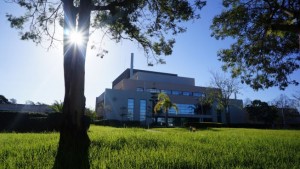Jennet Orayeva
IAEA Department of Nuclear Energy
Nuclear Research Centre of Maamora, Morocco. (Photo: CNESTEN)
With its electricity consumption expected to increase considerably in the coming years and with a high dependence on imported energy sources, Morocco is evaluating whether nuclear power could be an option for its 2030 energy mix. Affordable and clean energy is vital to meeting Morocco’s growing electricity demand to sustain its socio-economic development.
“Morocco’s national energy strategy is considering nuclear power as a long-term alternative to meet the country’s future needs, but no decision has been made so far,” said Khalid El Mediouri, Director General of the National Centre for Nuclear Energy, Sciences and Technology Techniques (CNESTEN) and Chair of the Nuclear Power and Seawater Desalination Committee (CRED), set up in 2009 by the Ministry of Energy, Mines, Water and Environment. “For this purpose, we undertook a global evaluation of these conditions alongside the infrastructure required for a nuclear power project compliant with international standards.”
Today, nearly 30 countries around the world are considering or actively embarking upon such a programme. The IAEA helps these countries build their knowledge in energy planning, analysis and nuclear expertise. In the past two years in Africa, the IAEA has conducted four Integrated Nuclear Infrastructure Review (INIR) missions to Ghana, Kenya, Morocco and Nigeria.
In October 2015, Morocco hosted an INIR mission and developed an action plan to address the mission’s recommendations and suggestions.
“Morocco recognizes the importance and the usefulness of the IAEA’s Milestones approachand its associated technical assistance programmes,” El Mediouri said, referring to an IAEA methodology that guides countries and organizations to work in a systematic way towards the introduction of nuclear power. “Through the integrated work plan, the IAEA continues its valuable assistance for the implementation of the INIR mission recommendations. This supports further progress in Morocco’s nuclear infrastructure development.”
Nuclear technology for socio-economic development
Morocco has participated actively in the IAEA technical cooperation programme to strengthen its capacities for the peaceful use of nuclear technology. Multiple projects have helped the country build local capabilities in conducting an energy planning study and nuclear power assessment. The country is also benefiting from an IAEA coordinated research project that helps decision makers consider all energy supply technology options.
The country’s experience with nuclear technology dates back to the 1950s: it has used nuclear techniques in medicine, agriculture and industrial applications. Under the supervision of CNESTEN, Morocco operates the MA-RA1 research reactor at the Maâmora Nuclear Research Centre. It is used for research in nuclear energy, neutron activation analysis, geochronology research, education and training.
Morocco is playing an important role in strengthening South–South cooperation by providing IAEA-supported education and training for African countries, mainly through regional designated centres in the fields of radiation safety, radiotherapy, nutrition, non-destructive testing and water resources.
IAEA energy planning tools help evaluate options
At the request of a Member State, the IAEA provides guidance and technical support for evaluating energy options, including nuclear energy. While this can contribute to sustainable development, the IAEA does not influence Members States’ choice of energy options. Its energy planning approach provides an opportunity to evaluate all energy options equally.
Integrated Nuclear Infrastructure Review (INIR)
The Integrated Nuclear Infrastructure Review (INIR) is a holistic peer review to assist Member States in assessing the status of their national infrastructure in respect of the introduction of nuclear power. The review covers the comprehensive infrastructure required for developing a safe, secure and sustainable nuclear power programme.
Upon request from a Member State, the IAEA conducts an INIR mission, sending a team of international experts who have direct experience in specialized nuclear infrastructure areas, and also IAEA staff. Before receiving an INIR mission, the country must complete a self-evaluation of the 19 nuclear power infrastructure issues included in the IAEA’s ‘Milestones’ approach, a comprehensive methodology that guides countries and organizations to work in a systematic way towards the introduction of nuclear power.
INIR missions enable IAEA Member State representatives to conduct in-depth discussions with international experts about experiences and best practices in nuclear power infrastructure development. Recommendations and suggestions are provided in a report to the Member State. By providing a comprehensive assessment of all facets of a nuclear power programme, spanning the regulatory body, utilities and all relevant government stakeholders involved, INIR helps ensure that the infrastructure required for the safe, secure and sustainable use of nuclear power is developed and implemented in a responsible and orderly manner.
For more information about the International Conference on the IAEA Technical Cooperation Programme: Sixty Years and Beyond – Contributing to Development, click here.








